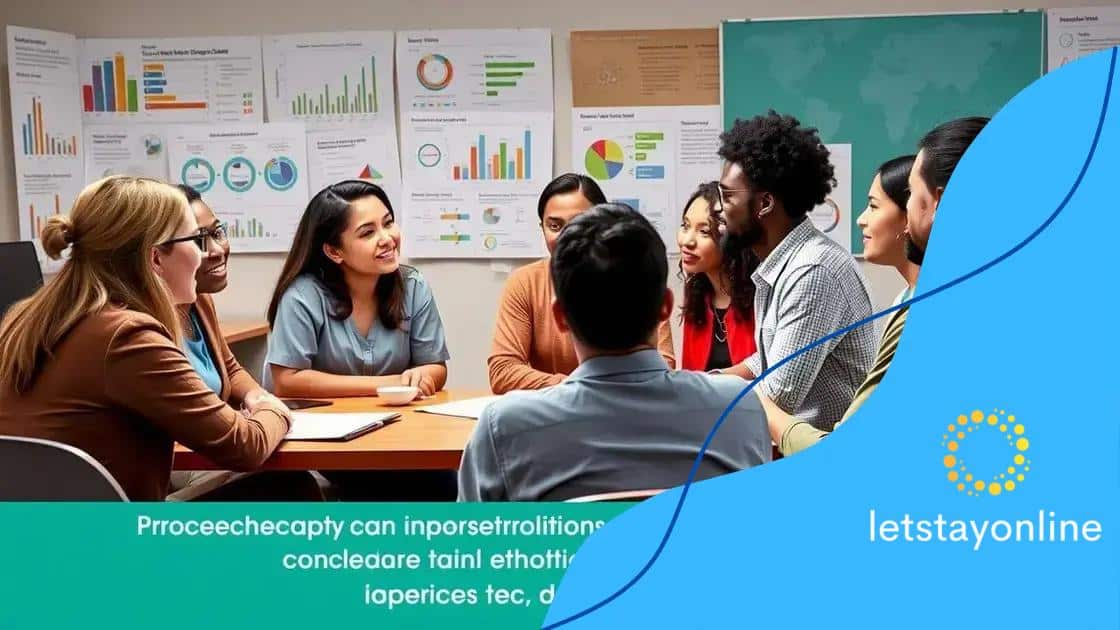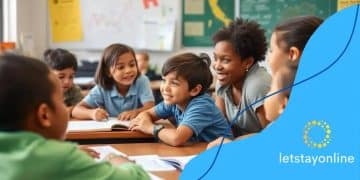Executive orders push for education decentralization

Executive orders push for education decentralization by promoting local decision-making, enhancing responsiveness to community needs, and allowing for personalized learning experiences, while also facing challenges like resource inequality and the need for effective training for local leaders.
Executive orders push for education decentralization, reshaping our traditional views on education. Have you ever wondered how this shift impacts students and communities? Let’s dive in.
Understanding education decentralization
Understanding education decentralization is essential for grasping the shifts happening in our school systems today. This concept involves distributing authority and decision-making closer to the local level. Rather than central authorities making all the choices, local governments, schools, and communities gain more autonomy. This can lead to more tailored and effective educational strategies, reflecting the unique needs of each area.
Key Aspects of Education Decentralization
There are several key aspects that define education decentralization:
- Local Control: Schools can adapt curricula and teaching methods to better fit community needs.
- Improved Accountability: Local officials are more directly responsible for educational outcomes.
- Increased Participation: Communities have a greater voice in educational decisions.
- Resource Allocation: Funds can be distributed based on local priorities and conditions.
This shift elevates the role of parents, teachers, and local leaders in shaping educational policy. Decentralization can result in a more engaged community that feels empowered to make changes. Communities can better address their own challenges and opportunities. Furthermore, adapting policies to specific local contexts can enhance the relevance of educational programs.
Benefits of Decentralization
There are notable benefits that come with this approach:
- Tailored Solutions: Every community faces unique challenges; decentralization allows for customized educational strategies.
- Flexibility: Schools can adapt quicker to changes, whether that be new policies, technologies, or community needs.
- Fostering Innovation: Educators are often in the best position to propose creative solutions that resonate with local students.
However, challenges such as resource inequalities and variable quality across regions can arise. These issues need to be acknowledged as we promote a decentralized educational framework. Attention to training local leaders and ensuring adequate resources will help address these disparities. Effective support and guidelines must be provided to ensure success. In essence, while education decentralization promotes local control, it simultaneously requires robust systems to maintain overall quality and equity in education.
The role of executive orders in education

The role of executive orders in education is significant, influencing policies that affect schools and students nationwide. These orders can introduce new regulations, allocate funding, and change educational standards. When executed properly, executive orders can lead to improvements in our educational systems.
Impact of Executive Orders
Executive orders shape the landscape of education in numerous ways:
- Policy Changes: Directing how educational institutions operate.
- Resource Allocation: Determining how funds are distributed among schools.
- Standard Setting: Implementing new academic standards and accountability measures.
Through these actions, leaders can address urgent issues. For example, during unprecedented times, executive orders can provide immediate solutions to educational challenges. They can promote access to learning for all students, making education more equitable.
Examples of Executive Orders
Several executive orders have made a notable impact on education:
- No Child Left Behind: Focused on improving educational outcomes for all children.
- Every Student Succeeds Act: Shifted more control to states while maintaining accountability.
- Support for STEM Education: Increased funding and resources for science, technology, engineering, and math education.
These examples show how executive actions can lead to significant reforms. Moreover, by prioritizing specific areas, policymakers can respond to the needs of various communities. As educational landscapes change, executive orders will likely remain a key tool in shaping policies that affect education.
Benefits of localized decision-making
The benefits of localized decision-making in education are substantial. By shifting authority closer to schools and communities, decisions can be more relevant and tailored to the specific needs of students and families. This approach encourages active participation from local stakeholders, ensuring their voices are heard.
Enhanced Responsiveness
One major advantage of localized decision-making is the ability to respond quickly to emerging challenges. For example, when a school faces budgetary constraints, local officials can make swift adjustments to resource allocation. Changes can include reallocating funds or designing new programs that directly address student needs without waiting for broader bureaucratic approval.
Increased Community Engagement
Localized decision-making fosters a deeper connection between schools and communities:
- Empowerment: Local stakeholders gain a sense of ownership in educational outcomes.
- Feedback Loop: Communities provide valuable insights that inform policy changes.
- Collaboration: Schools work with families and local organizations to create supportive environments.
This active collaboration enhances the educational experience for students. With local decision-making, schools can better align their objectives with community values and expectations.
Customized Solutions
Each community has unique challenges and strengths. Localized decision-making allows education providers to create solutions that suit their specific context. For instance, a rural school may focus on developing agricultural programs, while an urban school may prioritize technology integration. This customization leads to more relevant and engaging learning opportunities for students.
Moreover, localized decisions often promote innovation. When educators can experiment with new strategies, they can tailor educational approaches that resonate with their students. Local leaders are often best positioned to identify resources and methods that inspire engagement and enhance learning outcomes.
Challenges faced in decentralizing education

Decentralizing education offers many advantages, but it also comes with its own set of challenges. These challenges can affect how well the system works and whether it truly benefits students and communities.
Resource Inequality
One significant challenge is resource inequality. Not all communities have the same wealth or access to funds. Rural areas, for example, may struggle to gather the financial support needed for quality education. This can lead to disparities in educational resources, such as technology, facilities, and teacher salaries.
Inconsistent Quality
Inconsistent quality in education is another concern. When decision-making is handed to local authorities, the educational experience can vary greatly from one school to another. Some schools might implement innovative programs, while others may lag behind due to lack of experience or support.
Inadequate Training for Leaders
Often, local leaders may not have the proper training to make effective educational decisions. Proper guidance and professional development are crucial. Without adequate training, leaders might struggle with budgeting, policy implementation, or community engagement. This can hinder the effectiveness of decentralized initiatives.
Additionally, stakeholder engagement can be a challenge. While local involvement is encouraged, not all community members may feel motivated to participate. Building trust and ensuring that all voices are heard requires effort and clear communication from educational leaders.
Resistance to Change
Another hurdle is the resistance to change. Not everyone is ready to embrace decentralized education models. Some stakeholders may feel unsure about shifting power from central authorities. Addressing these concerns and helping communities understand the potential benefits of decentralization is essential.
Overcoming these challenges requires collaboration between local, state, and federal levels. By sharing resources, best practices, and support, communities can work together to create effective decentralized education systems. Building a solid support network can help alleviate many issues gradationally, ensuring that decentralization works for everyone.
Future trends in education policies
The future of education policies looks promising as new trends emerge. These trends reflect the changing needs of students and society. Education systems are adapting to prepare learners for a rapidly evolving world.
Personalized Learning
One trend gaining traction is personalized learning. Schools are beginning to tailor educational experiences based on individual student needs. This approach embraces diverse learning styles and paces. By leveraging technology, educators can create customized lessons that engage students more effectively.
Integration of Technology
The integration of technology in classrooms is another significant trend. Virtual classrooms, online resources, and educational apps are becoming common tools for teachers and students:
- Interactive Learning: Technology enables interactive assignments, fostering student engagement.
- Access to Resources: Online platforms provide students with access to a wealth of information and learning materials.
- Collaboration: Tools like video conferencing allow students to collaborate across geographical boundaries.
As technology evolves, so too will educational tools, enhancing the way knowledge is shared and absorbed. Furthermore, students will learn skills that are essential in the digital age.
Focus on Social-Emotional Learning
Future policies are also shifting towards a greater emphasis on social-emotional learning. Educators are recognizing the importance of mental health and emotional well-being in the learning process. Programs designed to foster emotional intelligence will become standard practice, helping students develop essential life skills.
Moreover, the growing concern for inclusivity and diversity in schools is shaping future education policies. Schools will increasingly focus on creating environments that respect and support all students, regardless of their background. This trend aims to ensure equitable opportunities for every learner.
These trends indicate a move towards more flexible, inclusive, and engaging education systems. By embracing change, education policies can better serve students and prepare them for the future.
In conclusion, the movement toward decentralizing education presents both exciting opportunities and significant challenges. By empowering local communities to make decisions, we can better address the unique needs of students and families. Emphasizing personalized learning, integrating technology, and focusing on social-emotional learning are key trends shaping the future. However, we must navigate challenges such as resource inequality and the need for adequate training for local leaders. By working together, we can create a more equitable and effective education system for all.
FAQ – Frequently Asked Questions about Education Decentralization
What is education decentralization?
Education decentralization is the process of transferring decision-making authority from central government to local authorities, schools, and communities.
What are the benefits of localized decision-making in education?
Localized decision-making allows for tailored educational strategies that meet the specific needs of communities, enhances engagement, and promotes quicker responses to local challenges.
What challenges does education decentralization face?
Challenges include resource inequality, inconsistent educational quality, inadequate training for local leaders, and resistance to change from stakeholders.
How does technology play a role in decentralized education?
Technology enhances personalized learning experiences, enables access to a wider range of resources, and supports collaboration among students and teachers across different locations.






